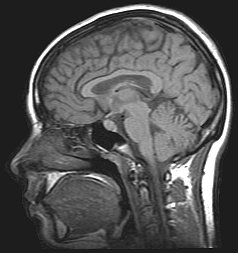Idiopathic intracranial hypertension
| Idiopathic intracranial hypertension | |
|---|---|
 |
|
| For IIH to be diagnosed, brain scans (such as MRI) must be performed to ensure there is no underlying cause for the increased pressure around the brain | |
| Classification and external resources | |
| Specialty | Neurology |
| ICD-10 | G93.2 |
| ICD-9-CM | 348.2 |
| OMIM | 243200 |
| DiseasesDB | 1331 |
| MedlinePlus | 000351 |
| eMedicine | neuro/329 oph/190 neuro/537 |
| Patient UK | Idiopathic intracranial hypertension |
| MeSH | D011559 |
Idiopathic intracranial hypertension (IIH), sometimes called by the older names benign intracranial hypertension (BIH) or pseudotumor cerebri (PTC), is a neurological disorder that is characterized by increased intracranial pressure (pressure around the brain) in the absence of a tumor or other diseases. The main symptoms are stroke-like headache, nausea, and vomiting, as well as pulsatile tinnitus (sounds perceived in the ears, with the sound occurring in the same rhythm as the pulse), double vision and other visual symptoms. If untreated, it may lead to swelling of the optic disc in the eye, which can progress to vision loss.
IIH is diagnosed with a brain scan (to rule out other causes) and a lumbar puncture; lumbar puncture may also provide temporary and sometimes permanent relief from the symptoms. Some respond to medication (with the drug acetazolamide, Topiramate, Furosemide, others or a combination), but others require surgery to relieve the pressure. The condition may occur in all age groups, but is most common in women aged 20–40.
The most common symptom of IIH is headache, which occurs in almost all (92–94%) cases. It is characteristically worse in the morning, generalized in character and throbbing in nature. It may be associated with nausea and vomiting. The headache can be made worse by any activity that further increases the intracranial pressure, such as coughing and sneezing. The pain may also be experienced in the neck and shoulders. Many have pulsatile tinnitus, a whooshing sensation in one or both ears (64–87%); this sound is synchronous with the pulse. Various other symptoms, such as numbness of the extremities, generalized weakness, loss of smell, and loss of coordination, are reported more rarely; none are specific for IIH. In children, numerous nonspecific signs and symptoms may be present.
...
Wikipedia
